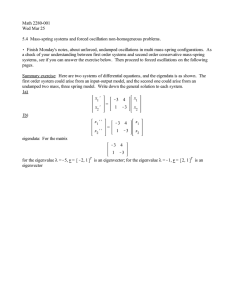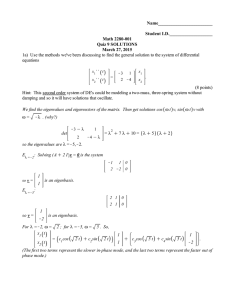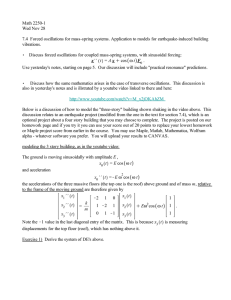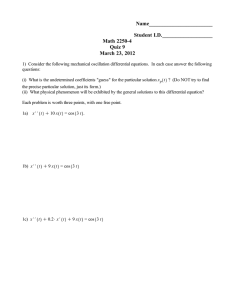Math 2250-4 Tues Apr 16
advertisement
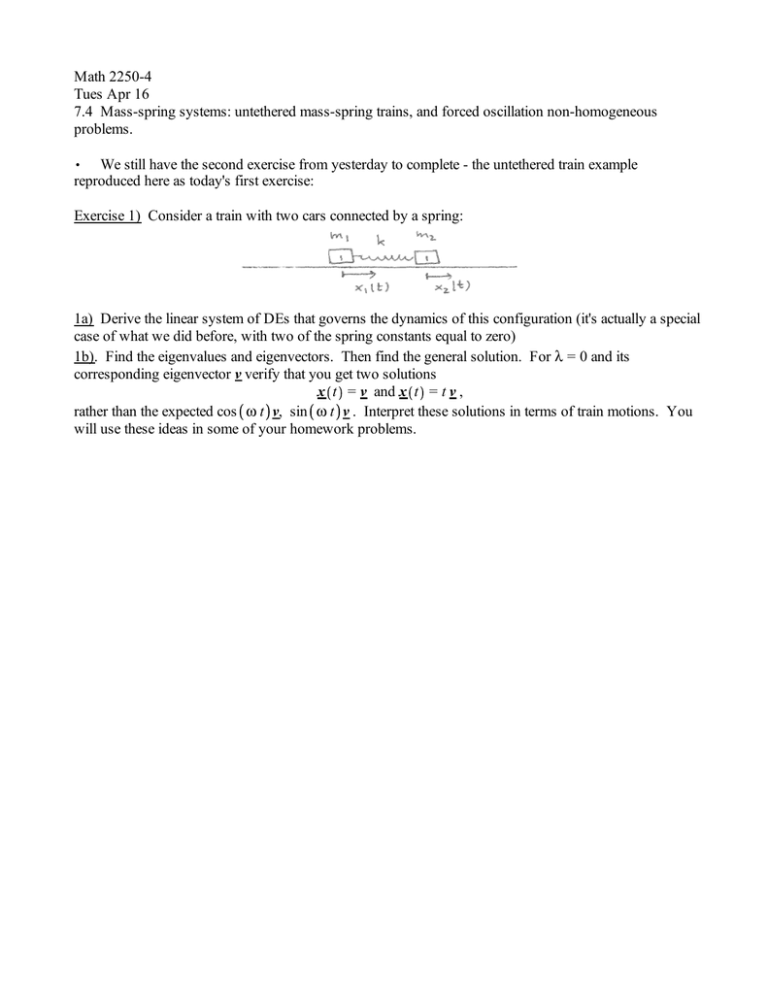
Math 2250-4 Tues Apr 16 7.4 Mass-spring systems: untethered mass-spring trains, and forced oscillation non-homogeneous problems. , We still have the second exercise from yesterday to complete - the untethered train example reproduced here as today's first exercise: Exercise 1) Consider a train with two cars connected by a spring: 1a) Derive the linear system of DEs that governs the dynamics of this configuration (it's actually a special case of what we did before, with two of the spring constants equal to zero) 1b). Find the eigenvalues and eigenvectors. Then find the general solution. For l = 0 and its corresponding eigenvector v verify that you get two solutions x t = v and x t = t v , rather than the expected cos w t v, sin w t v . Interpret these solutions in terms of train motions. You will use these ideas in some of your homework problems. Forced oscillations (still undamped): M x## t = K x C F t 0 x## t = A x C M K1 F t . If the forcing is sinusoidal, M x## t = K x C cos w t G0 0 x## t = A x C cos w t F0 with F0 = M K1 G0 . From the fundamental theorem for linear transformations we know that the general solution to this inhomogeneous linear problem is of the form x t = xP t C xH t , and we've been discussing how to find the homogeneous solutions xH t . As long as the driving frequency w is NOT one of the natural frequencies, we don't expect resonance; the method of undetermined coefficients predicts there should be a particular solution of the form xP t = cos w t c where the vector c is what we need to find. Exercise 2) Substitute the guess xP t = cos w t c into the DE system x## t = A x C cos w t F0 to find a matrix algebra formula for c = c w . Notice that this formula makes sense precisely when w is NOT one of the natural frequencies of the system. Solution: 2 c w =K A C w I 2 K1 F0 . Note, matrix inverse exists precisely if Kw is not an eigenvalue. Exercise 3) Continuing with the example from Monday, and taking the case k = m , consider the special case of the previous page's discussion. Here we are forcing the second mass sinusoidally: x ## t 1 x ## t = K2 1 1 K2 2 x 1 C cos w t x 2 0 3 We know from previous work that the natural frequencies are w1 = 1, w2 = xH t = C1 cos t K a 1 1 3 t K a2 C C2 cos 3 and that 1 . 1 K1 Find the formula for xP t , as on the preceding page. Notice that this steady periodic solution blows up as w/1 or w/ 3 . Solution: As long as w s 1, 3 , the general solution x = xP C xH is given by 3 x t 1 x t 2 = cos w t 2 w K1 w K3 6K3 w 2 2 2 w K1 C C1 cos t K a 1 2 w K3 1 C C2 cos 3 t K a2 1 . 1 K1 Interpretation as far as inferred practical resonance for slightly damped problems: If there was even a small amount of damping, the homogeneous solution would actually be transient (it would be exponentially decaying and oscillating - underdamped). There would still be a sinusoidal particular solution, which would have a formula close to our particular solution, the first term above, as long as w s 1, 3 . (There would also be a relatively smaller sin w t d term as well.) So we can infer the practical resonance behavior for different w values with slight damping, by looking at the size of the c w term for the undamped problem....see next page for visualizations. > > > > > restart : with LinearAlgebra : A d Matrix 2, 2, K2, 1, 1,K2 F0 d Vector 0, 3 : Iden d IdentityMatrix 2 : 2 > c d w/ A C w $Iden > cw ; : K1 . KF0 : # the formula we worked out by hand 3 2 3K4 w Cw K 3 K2 C w 4 (1) 2 2 3K4 w Cw 4 > with plots : with LinearAlgebra : > plot Norm c w , 2 , w = 0 ..4, magnitude = 0 ..10, color = black, title = `practical resonance` ; # Norm(c(w),2) is the magnitude of the c(w) vector practical resonance 10 8 magnitude 6 4 2 0 > plot Norm c 0 1 2 w 3 4 2$Pi , 2 , T = 0 ..15, magnitude = 0 ..15, color = black, title T = `practical resonance as function of forcing period` ; practical resonance as function of forcing period 15 10 magnitude 5 0 0 5 10 T > 15 There are strong connections between our discussion here and the modeling of how earthquakes can shake buildings: As it turns out, for our physics lab springs, the modes and frequencies are almost identical: , An interesting shake-table demonstration: http://www.youtube.com/watch?v=M_x2jOKAhZM Below is a discussion of how to model the "three-story" building shown shaking in the video above. This discussion relates to an earthquake project (modified from the one in the text for section 7.4), which is an optional project about a four story building that you may choose to complete. The project is posted on our homework page and if you try it you can use your score out of 20 points to replace your lowest homework or Maple project score from earlier in the course. You may use Maple, Matlab, Mathematica, Wolfram alpha - whatever software you prefer. You will upload your results to CANVAS. modeling the 3 story building, as in the youtube video: The ground is moving sinusoidally with amplitude E , x0 t = E cos w t and acceleration 2 x0 ## t =KE w cos w t the accelerations of the three massive floors (the top one is the roof) above ground and of mass m, relative to the frame of the moving ground are therefore given by x1 ## t x1 t K2 1 0 1 x2 ## t x3 ## t = k m 1 x2 t 1 K1 x3 t 1 K2 0 C Ew2 cos w t 1 . 1 Note the K1 value in the last diagonal entry of the matrix. This is because x3 t is measuring displacements for the top floor (roof), which has nothing above it. Exercise 4) Derive the system of DE's above. k = 1 . For the scaled matrix you'd have the same m k eigenvectors, but the eigenvalues would all be multiplied by the scaling factor and the natural m k frequencies would all be scaled by . Symmetric matrices like ours (i.e matrix equals its transpose) m are always diagonalizable with real eigenvalues and eigenvectors...and you can choose the eigenvectors to be mutually perpendicular. This is called the "Spectral Theorem for symmetric matrices" and is an important fact in many math and science applications...you can read about it here: http://en.wikipedia. org/wiki/Symmetric_matrix.) If we tell Maple that our matrix is symmetric it will not confuse us with unsimplified numbers and vectors that may look complex rather than real. Here is eigendata for the unscaled matrix > with LinearAlgebra : > A d Matrix 3, 3, K2.0, 1, 0, 1,K2, 1, 0, 1,K1 ; # I used at least one decimal value so Maple would evaluate in floating point A := K2.0 1 0 1 K2 1 0 1 K1 (2) > Digits d 5 : # 5 digits should be fine, for our decimal approximations. > eigendata d Eigenvectors Matrix A, shape = symmetric : # to take advantage of the # spectral theorem lambdas d eigendata 1 : #eigenvalues evectors d eigendata 2 : #corresponding eigenvectors - for fundamental modes omegas d map sqrt,Klambdas ; # natural angular frequencies 2$evalf Pi f d x/ : x periods d map f, omegas ; #natural periods eigenvectors d map evalf, evectors ; # get digits down to 5 1.8019 1.2470 omegas := 0.44504 3.4870 periods := 5.0386 14.118 K0.59101 K0.73698 0.32799 eigenvectors := > 0.73698 K0.32799 0.59101 K0.32799 0.59101 0.73698 (3) Exercise 5) Interpret the data above, in terms of the natural modes for the shaking building . In the youtube video the first mode to appear is the slow and dangerous "sloshing mode", where all three floors oscillate in phase, with amplitude ratios 33 : 59 : 74 from the first to the third floor. What's the second mode that gets excited? The third mode? (They don't show the third mode in the video.) Exercise 6) Could you modify the matrix algebra, and then the commands earlier in today's notes, to create practical resonance graphs as we did there? Remark) All of the ideas we've discussed in section 7.4 also apply to molecular vibrations. The eigendata in these cases is related to the "spectrum" of light frequencies that correspond to the natural fundamental modes for molecular vibrations.




